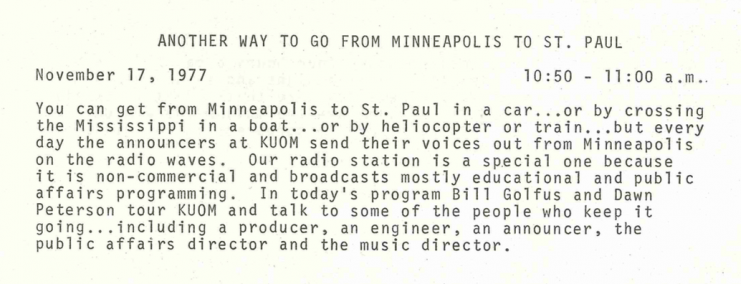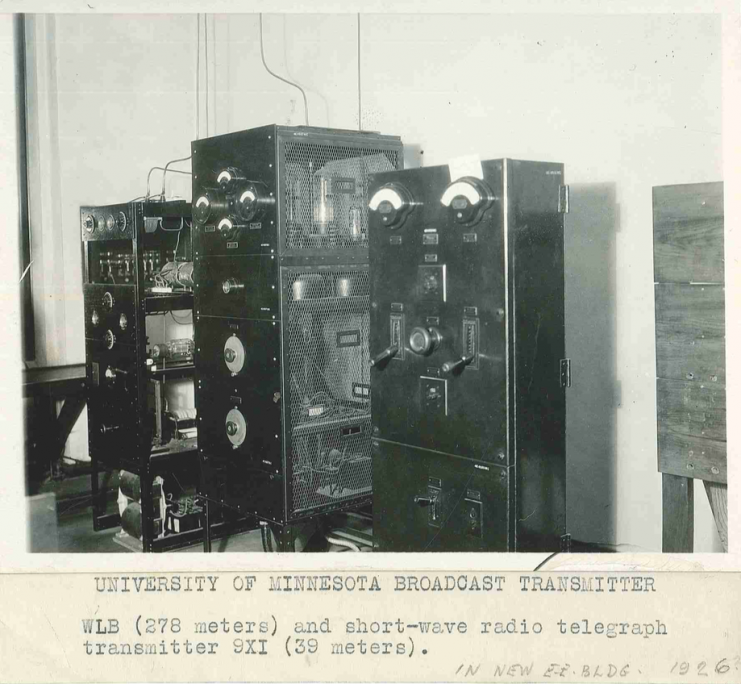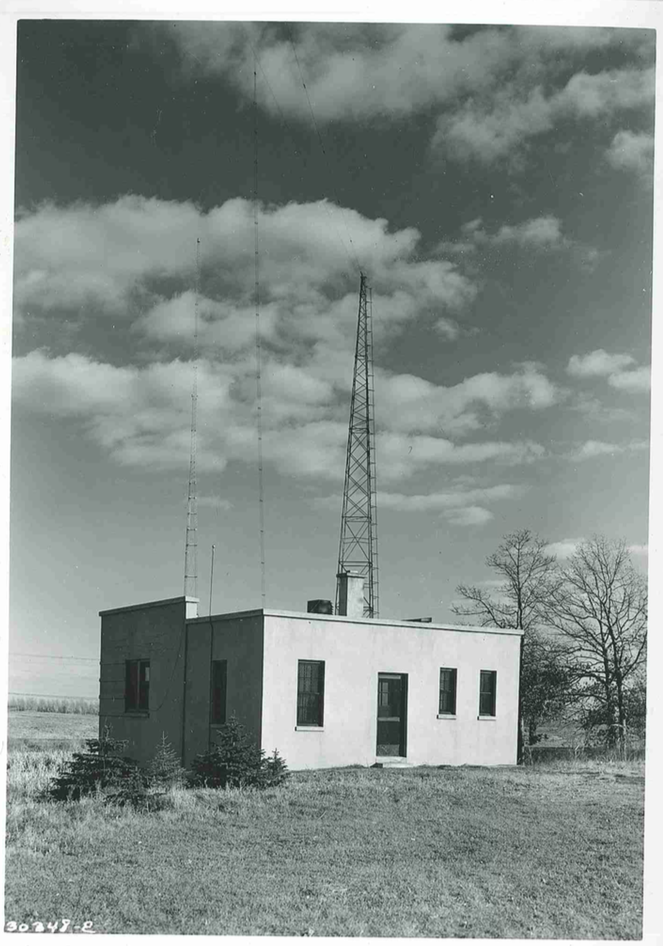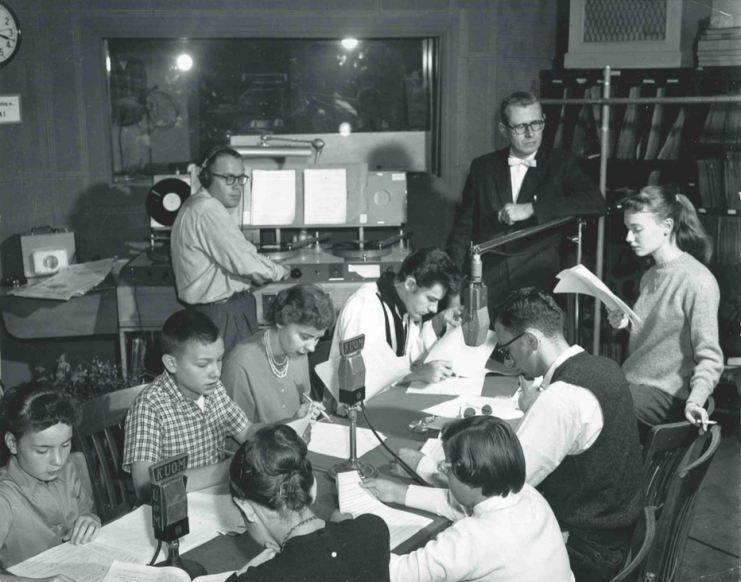You are listening to U of M Radio on your Historic Dial!
From 1938-1979, the Minnesota School of the Air brought educational programs into the classrooms of Minnesota and beyond over radio airwaves and through tape transcription. During the 1977-1978 season, School of the Air produced a series of radio “field trips” called Look What We Found, a program that introduced students to people and places in Minnesota. Join us this season as we revisit these radio field trips. Today’s episode takes listeners another way to go from Minneapolis to St. Paul!
Season 2: Episode 3. Another Way to Go From Minneapolis to St. Paul
Podcast (umnradio): Play in new window | Download
You are listening to U of M Radio on your Historic Dial podcast. Welcome to Season 2: Episode 3.
Hi, this is Rebecca from University Archives. Today’s field trip in sound on the program “Look What We Found” is more of a staycation. On the November 17, 1977 episode, program announcers Walter, Patty, and Bill, gave a tour of the KUOM radio studios and interviewed the staff at the station. The title of the program, “Another Way to Go From Minneapolis to St. Paul,” notes that the radio station is in more than one place: the studio, in Rarig Center on the West Bank campus in Minneapolis, and the transmitter located on the St. Paul campus.
Before we listen to a guided tour of KUOM studios in Rarig Center in 1977, let’s look back at some other places on campus where KUOM was once located. As early as 1912, Electrical Engineering professor Franklin Springer began experimenting with wireless telegraphy, and by 1914 the department was offering coursework in radio transmission and operation. When Cyril M. Jansky, Jr. joined the department in 1920, he applied for an experimental license and began limited broadcasting under the call letters 9XI. On January 13, 1922, the department received a non-commercial radio broadcast license and was assigned the call letters WLB. After a new Electrical Engineering Building was built on campus in 1925, the department outfitted the building with a radio studio where broadcasting continued in the spring of 1926.
The April 17, 1926 edition of the Minnesota Alumni Weekly featured a description of the studio in the article, “U Has Complete Radio Plant.” The article stated that “The station has been under construction for some time, and consists of one room on the third floor of the Engineering building, fully equipped with a transmitter, microphone, and acoustical material. The walls are deadened and hung with heavy curtains. Wicker furniture and a grand piano are placed at the convenience of entertainers.”
In 1938, the University purchased a new transmitter that was erected on the St. Paul campus. A new home for the radio studio was made in Eddy Hall in 1939.
The University publication Minnesota Chats featured an article about the studio in Eddy on May 2, 1939 titled, “University Radio Station Busy in New Home.” The article stated, “The layout contains four studios for broadcasting, two of them large enough to accommodate casts of considerable size in dramatic or musical numbers, a main control room, a smaller control room adjoining the largest studio, ample office space, and air conditioning equipment made necessary by the fact that the quarters must be kept closed to eliminate outside disturbances.”
Radio station WLB – which changed the call letters to KUOM for K University of Minnesota in 1945 – operated from Eddy Hall from 1939 to 1974 when it moved into new studios in Rarig Center.
Okay, now that we are all caught up on the history of KUOM locations at the University we can return to 1977 to Rarig Center for the November 17, 1977 episode of Look What We Found, titled “Another Way to Go From Minneapolis to St. Paul.”
Broadcast Transcript
[Music]
Various voices: It’s fabulous! [unintelligible] I don’t know.
[Group exclamation] Look What We Found!
Announcer: Come on you’ve been sitting there far too long. Join the Minnesota School of the Air as we take a field trip in sound to someplace you’ve probably never been, somewhere in and around the Twin Cities. And here to go with you are your hosts Walter, Patty, and Bill.
Patty: Hi Billy, who’s your friend?
Bill: This is my friend Dawn Peterson.
Walter & Patty: Hi Dawn!
Bill: Dawn wanted to take a tour through the radio station. And I thought as long as we were going to go we might as well take our listeners along.
Walter: Good idea. Well, what do you want to know about radio Dawn?
Dawn: Well, uh what do you do?
Walter: Well, I’m a producer. I produce the programs that are designed for people your age to listen to in the classroom, for The Minnesota School of the Air.
Dawn: Well, what’s a producer?
Walter: Well, the producer takes an idea or a script for a program and sees that all the elements come together, that is actors reading lines, music, and sound effects. Now we use sound effects in order to provide a kind of a background for a scene. Let’s say a scene takes place in the country then we want to have the sounds of birds so you get the idea that you’re walking down a country lane for instance.
[Birds chirping]
Walter: Or if the scene takes place in the city then you want to have oh traffic noises and things like that to give the idea that you’re somewhere in town.
[Car noises]
Walter: And we use music to well set a mood for a scene. Let’s say something is happening that is really frightening then we want to use scary music.
[Slow, ominous music]
Walter: And if the scene that’s happening is really happy then we want music that sets that kind of a mood.
[Upbeat, fast music]
Walter: And you know there are many ways that we can move from scene to scene on radio too. Uh, for instance, we can use a musical transition, and there’s lots of different kinds of music you can use to bridge between a scene depending on the mood you want to set. Another way to do it is to do what’s called a crossfade. You have one voice speaking and that voice gradually starts to get quieter and moves farther away and pretty soon you hear another voice… [fades]
Bill: And then you have another voice which comes in and gets louder and louder and louder, and that indicates a change of time or a change of place.
Walter: And if you want to get rid of somebody it’s really easy because the engineer in the control room can just fade you out so when somebody starts to get boring, gradually they get further away and you don’t hear them anymore until finally they’re gone and you’re rid of them… [fades]
Dawn: Sounds interesting
Bill: Well I’ll tell you what why don’t we leave you here.
Walter: Okay
Bill: And Dawn and I will take a tour into master control room right now.
[Music transition]
Bill: Kinda looks like the bridge of the Starship Enterprise doesn’t it?
Dawn: Sure does. I feel like Lieutenant Uhura or someone.
Bill: Stewart do you want to tell us a bit about the master control room and what all of this equipment is?
Stewart: Sure Bill, uh, this here is our mixing console mixing board with this we direct the signal to the transmitter and then it goes out over the air. There are, um, 14 channels on it, it is a big, flat, board, with um, lots of lights on it and some dials and some push buttons and some switches, and all you have to do it push the right switches, and push the right levers, and we get on the air. My primary responsibility is indeed to see that the program comes out and sounds good.
[Music transition]
Bill: Now let’s go talk to the chief announcer, Lars Hoell.
Lars: Hello, here we are in the newsroom. There is a big room where we assemble the news and then there is a smaller room where the teletype machines are.
Dawn: Uh-huh, and these are the teletypes?
Lars: Right. We have essentially two teleprinters. Both are from the Associated Press. One prints news that can be read without any editing and in other words you could simply take this copy off the teleprinter and go right into the studio and read it as it is written. That’s called the radio wire. This other teleprinter here is specifically for newspapers, the, ah, print media. And if we use news that comes off this teleprinter, we have to rewrite it because it is written to be read, you know, in a newspaper, not to be read aloud.
Dawn: Right.
Lars: Let me, uh, let me rip some news as long as we’re in here. Hold on a minute.
[Machine sounds, paper ripping sounds]
Lars: So, I take the individual news stories and I rip them apart and I look at them an arrange them in categories, and that way I can organize my newscasts logically. Most often things that happen internationally are real important, you know, the future of the world and all that and so I like to read those stories first. Then national stories are very important because of legislation in Congress and what not and I read those stories a little later and then the Minnesota stories come last.
Dawn: Thank you very much
Lars: Oh, you are welcome
[Music transition]
Dawn: Hi what’s your name and what do you do?
Andy: I’m Andy Marlow and I’m the Public Affairs director at KUOM.
Dawn: And what does a Public Affairs director do?
Andy: Well, I produce programs about political and social issues about things that you’d probably see on the front page of your newspaper or at least in the first section. Um, I try to find things that are part of the news but provide a little more background, more information. In other words, I go more in-depth than would happen on a newscast where maybe 30 seconds is devoted to one story I can devote a whole hour to one story.
Dawn: Where do you get your news?
Andy: Well it comes from a lot of places, some of it I manufacture by having people come into the studio and discuss an important issue, by interviewing an author of a book who has some new ideas on a particular subject. Sometimes I’ll get the material from our network National Public Radio in Washington. It can come in many different ways.
Bill: Andy what’s the difference between public affairs that you do and something that we might read in the newspaper?
Andy: Well, there are lots of differences Bill. One is that in order for us to do a story there really has to be a sound component to it. A newspaper can write about a bunch of numbers from the county auditors books or some dry facts but we have to have some sound to it in order to make it interesting for people to listen to.
[Music transition]
Bill: Now let’s go talk to Curt Oliver who’s the music director at our station. Hi Curt, we’re taking a tour of the radio station, this is my friend Dawn Peterson.
Curt: Hi Dawn
Dawn: Hi. What do you do here?
Curt: Well I decide which music is going to be played, when it’s going to be played, and order the records and make sure they’re on the shelf at the right place.
Dawn: Well, what kind of music do you play?
Curt: Well, mostly it’s classical music because we’ve… well, ever since the station first signed on the air in the 20’s, we’ve been playing classical music. And uh, that’s what we’re doing right now in fact as I’m sitting here in the studio. It’s The Afternoon Concert and we’re listening to some orchestral music.
Dawn: Okay, um, do you do any other music besides classical? Is there…
Curt: Yes, we do some other, uh, we do a very little bit of folk music. And
we do have, uh, ethnic programs that is programs which are for minorities, for blacks, for Indians, for Chicano’s, and the program I shouldn’t say for because it’s really made by people. The programming for the black audience is done by black people and I don’t pick that music out we leave that to the people who do the programming.
Dawn: Uh huh
[Musical transition]
Bill: Well we’re back
Patty: Did you have a good time?
Dawn: Yeah it was really fun
Walter: Glad you liked it, but we’d better get out of here because there are other programs that are going to be coming on right after this one and we don’t want to keep anyone waiting right?
Bill: Buh-bye
Walter: Bye
Patty: Bye
Dawn: Bye!
Announcer: Producers for Look What We Found are Patty Goodwin, Bill Golfus, and Walter Brody. Join us next time for another field trip in sound brought to you by The Minnesota School of the Air.
The U of M on Your Historic Dial podcast is produced by University Archives for your enjoyment. Subscribe or download on iTunes or GooglePlay so you don’t miss another moment of historic Minnesota radio.
Recordings of the program series Look What We Found were digitized in 2016 in part with funds provided by the State of Minnesota from the Arts and Cultural Heritage Fund through the Minnesota Historical Society.
—Rebecca Toov is the collections archivist for the University of Minnesota Archives.










